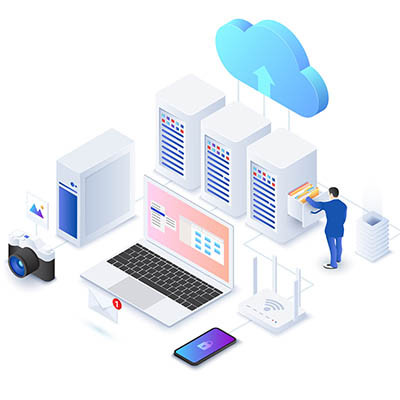SMBs tend to pride themselves on how well they’re able to treat their customers. Larger enterprises sometimes lack the personalized attention that customers of small businesses get, despite having the tools to make it happen. Small businesses can also achieve this goal, and it’s all thanks to customer relationship management solutions. The right tool can improve sales, marketing efforts, and even customer satisfaction.
Global Tech Solutions Blog
One piece of technology that's become essential to modern business is the cloud. You hear the term constantly, but what does it actually mean for your business, especially as we navigate 2025? Today, we unpack this very topic.
Our team specializes in proactive business technology support, and helping organizations understand and leverage the cloud is a core part of what we do. Forget confusing jargon; let's break down what the cloud is and why it's a powerful tool for businesses of all sizes.
If you’re a smart manager, you're always looking for ways to optimize spending and enhance your organization’s ability to be efficient. Voice over Internet Protocol (VoIP) isn't just a trendy tech term; it's a strategic financial move that can significantly impact your bottom line. Today, we get into how VoIP translates to real cost savings.
How much time and money do you spend wrestling with your business’ software? Between updates, license renewals, and that one employee who keeps accidentally deleting their email app, it’s enough to make you want to scream. Unfortunately, software is kind of non-negotiable. You need it. So, should you go old school and buy it outright, or should you consider moving to the cloud and employing Software-as-a-Service?
The cloud comes in a few different forms. You have private cloud solutions, which are those that a business maintains in-house for their own use, and you have public cloud solutions, which are those that an external business hosts and provides to subscribers. While both have their place in modern business operations, we wanted to take a few moments to focus on the public cloud and the various benefits that it has to offer.
Finding affordable data storage isn’t the challenge it used to be. In fact, some sources say the costs are dropping by 20-to-30 percent annually. This means that businesses that thought cost was a roadblock to using the cloud for their data storage needs, can rest assured that they can confidently go on and secure the amount of secure cloud storage they need.
The telephone cemented itself as a valuable tool of business long ago, but the ways that businesses use these devices have changed over the years. Thanks to advancements in technology, telephones can still be used by businesses even today, albeit with some modern adjustments to stay competitive and useful. One of these telephony solutions is Voice over Internet Protocol, or VoIP for short.
The cloud has been a good resource for business for quite a while. Just how good? Currently, nine-out-of-ten businesses operate with some type of cloud-hosted solution. In fact, by the figures, we’re definitely looking at a cloud-hosted future. We thought it would be interesting to take a look at some of the cloud computing stats and trends to paint a picture of just how the cloud has grown up.
Cloud computing is turning into a tool that is universally used by businesses to enhance remote access and provide the scalability for tools that allows a business to get the best bang for their buck. This month, we’ll describe how modern cloud computing works and why it is such a huge potential benefit for your business.
Businesses must often store documents for the purposes of compliance, but anyone who has managed a document storage system that uses physical documents, like filing cabinets or otherwise, knows that it can get a little complicated and messy. Technology offers better alternatives that make things easier, efficient, and most important of all, more secure.
There is no denying the versatility that technology like the cloud can provide, but it often comes with hidden costs that might affect its cost-to-benefit ratio for your organization. Here are some of these hidden costs, as well as what you can do to minimize the impact they have on your bottom line.
Email is a solution that your business uses just about every single day, and as one of your central methods of communication, you need to consider how it’s managed and maintained. Thankfully, modern businesses have more choices available to them than ever before, some of which are so hands-off and easy that they can completely change how a business views their email.
You may already be familiar with the concept of hosting your business’ technology on your own in-house network, like a server unit, but some businesses struggle to manage hardware like this effectively. In all honesty, you can get largely the same benefits of an in-house server through a hosted solution. Nowadays, the cloud makes utilizing cloud services easier than ever.
The cloud is a popular choice for businesses that need access to tools to sustain operations, but there is an innate flaw that comes from hosting anything in an online environment: security. Do not pretend that security is not an issue for your cloud-based resources—failing to acknowledge the importance of security could be a fatal mistake for organizations that leverage cloud-based technology resources.
The cloud is a great tool that lets businesses of all industries and sizes revisit the way operations are handled, but it’s not always clear what the best approach is for your specific business. What are some ways that you can utilize the cloud, and why is it so important that you start thinking about these benefits now?
For all the communication services and tools available to businesses nowadays, the telephone remains a staple in everyday processes—despite it often being difficult to manage and expensive to maintain. This is largely because today’s technology enables businesses to use a telephone system that exceeds the capabilities once provided by telephony, for a far more manageable investment.
With cloud computing being utilized by a majority of businesses nowadays, it’s not as big of a surprise when one wants to move files from a locally-hosted server to a cloud server; or, from a cloud server to a new cloud server. This presents a fair amount of problems that you have to be mindful of if you want to move the data and applications over properly. Today, we’ll take a look at some problems you may face, and how to make sure they don’t weigh down your next cloud migration.





















